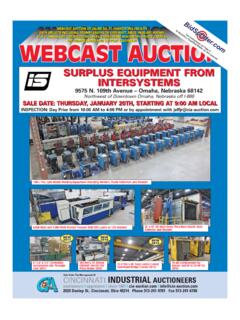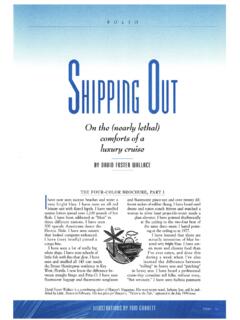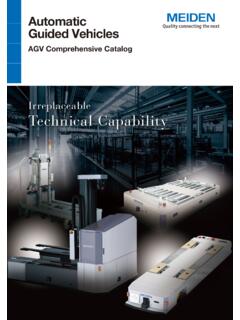Transcription of 9.11.1 Vegetable Oil Processing
1 11/95 Food And Agricultural Vegetable Oil General1-5 The industry group producing fats and oils includes cottonseed oil mills, soybean oil mills, Vegetable oil mills (other than corn, cottonseed, and soybean), and other mills. Wet corn mills are theprimary producers of corn oil. Approximately 137 Vegetable oil plants operate in the United States. Soybean Processing , which dominates the industry, produces approximately 80 percent of the volumeof Vegetable oil and is concentrated in the states of Iowa, Illinois, Missouri, Kansas, Indiana, andMinnesota, but also found across the nation. Likewise, wet corn mills are concentrated in Corn Beltstates. Cottonseed oil mills are found in southern states and Process Description 6-9 The following process description discusses only soybean oil manufacture, because emissionfactors are available only for that activity. Corn, cottonseed, and peanut oil Processing are similar tosoybean Processing , except for differences in the soybean preparation for oil extraction.
2 The processfor soybeans typically consists of five steps: oilseed handling/elevator operations, preparation ofsoybeans for solvent extraction, solvent extraction and oil desolventizing, flake desolventizing, and Handling/Elevator Operations -Figure is a schematic diagram of a typical soybean handling/elevator operation thatprecedes the preparation of soybeans for the solvent extraction process. Soybeans received at the facility by truck or rail are sampled and analyzed for moisture content,foreign matter, and damaged seeds. Then the beans are weighed and conveyed to large concrete silosor metal tanks for storage prior to Processing . When the facility is ready to process the soybeans, thebeans are removed from the silo or tank and cleaned of foreign materials and loose hulls. Screenstypically are used to remove foreign materials such as sticks, stems, pods, tramp metal, sand, and dirt. An aspiration system is used to remove loose hulls from the soybeans; these hulls may be combinedlater with hulls from the dehulling aspiration step.
3 The beans are passed through dryers to reduce theirmoisture content to approximately 10 to 11 percent by weight and then are conveyed to process bins fortemporary storage and tempering for 1 to 5 days in order to facilitate Of Soybeans For Solvent Extraction -Figure is a schematic diagram of the process used to prepare soybeans for the solventextraction process. The process, which is fairly well standardized, consists of four principal operations: cracking, dehulling/hull removal, conditioning, and are conveyed from the process bins to the mill by means of belts or mass flowconveyors and bucket elevators. In the mill, the beans may be aspirated again, weighed, cleaned oftramp metal by magnets, and fed into corrugated cracking rolls. The cracking rolls "crack" each beaninto four to six particles, which are passed through aspirators to remove the hulls (processed separatelyafter the removal of residual bean chips). These hulls may be combined with the hulls from the graincleaning SoybeanReceiving(3-02-007-81)Handling/St orage(3-02-007-82)Grain Cleaning(3-02-007-83)Grain Drying(3-02-007-84)Process BinsSoybeans To Preparation(see Figure )Particulate EmissionsParticulate EmissionsHulls (may be combined with hulls from dehulling aspiration)(see Figure )Particulate FACTORS11/95 Figure Flow diagram of typical soybean handling/elevator operations.
4 (Source Classification Codes in parentheses.)Cracking(3-02-007-85)Dehull ing Aspiration(3-02-007-85)Cracked Bean Conditioning(3-02-007-87)Flaking(3-02-00 7-88)Dehulling Aspiration(3-02-007-85)AspirationParticu lateEmissionsParticulateEmissionsParticu lateEmissionsFlakes to Solvent Extraction(see Figure )Hulls with BeansHulls from Grain Cleaning(see Figure )HullsHulls to Sizing, Grinding, and Loadout(see Figure )OPTIONAL PROCESSS oybeans fromHandling/Elevator Operations(see Figure )ParticulateEmissionsBean ReturnParticulateEmissions11/95 Food And Agricultural Flow diagram of the typical process for preparing soybeans for solvent extraction.(Source Classification Codes in parentheses.) FACTORS11/95 Next, the cracked beans and bean chips are conveyed to the conditioning area, where they areput either into a rotary steam tubed device or into a stacked cooker and are heated to "condition" them(i. e., make them pliable and keep them hydrated). Conditioning is necessary to permit the flaking ofthe chips and to prevent their being broken into smaller particles.
5 Finally, the heated, cracked beans areconveyed and fed to smooth, cylindrical rolls that press the particles into smooth "flakes", which varyin thickness from approximately to millimeters ( to inches). Flaking allows thesoybean oil cells to be exposed and the oil to be more easily Extraction and Oil Desolventizing -The extraction process consists of "washing" the oil from the soybean flakes with hexanesolvent in a countercurrent extractor. Then the solvent is evaporated (i. e., desolventized) from both thesolvent/oil mixture (micella) and the solvent-laden, defatted flakes (see Figure ). The oil isdesolventized by exposing the solvent/oil mixture to steam (contact and noncontact). Then the solventis condensed, separated from the steam condensate, and reused. Residual hexane not condensed isremoved with mineral oil scrubbers. The desolventized oil, called "crude" soybean oil, is stored forfurther Processing or Flakes -The flakes leaving the extractor contain up to 35 to 40 percent solvent and must bedesolventized before use.
6 Flakes are desolventized in one of two ways: either "conventional"desolventizing or specialty or "flash" desolventizing. The method used depends upon the end use of theflakes. Flakes that are flash desolventized are typically used for human foods, while conventionallydesolventized flakes are used primarily in animal feeds. Conventional desolventizing takes place in a desolventizer-toaster (DT), where both contactand noncontact steam are used to evaporate the hexane. In addition, the contact steam "toasts" theflakes, making them more usable for animal feeds. The desolventized and toasted flakes then pass to adryer, where excess moisture is removed by heat, and then to a cooler, where ambient air is used toreduce the temperature of the dried flakes. The desolventized, defatted flakes are then ground for useas soybean meal (see Figure ).Flash desolventizing is a special process that accounts for less than 5 percent by volume of theannual nationwide soybean crush. The production of flakes for human consumption generally followsthe flow diagram in Figure for the "conventional" process, except for the desolventizing step.
7 In this step, the flakes from the oil extraction step are "flash" desolventized in a vacuum withnoncontact steam or superheated hexane. This step is followed by a final solvent stripping step usingsteam. Both the hexane vapor from the flash/vacuum desolventizer and the hexane and steam vaporsfrom the stripper are directed to a condenser. From the condenser, hexane vapors pass to the mineraloil scrubber and the hexane-water condensate goes to the separator, as shown in Figure Theflakes produced by the flash process are termed "white flakes". A process flow diagram for the flashdesolventizing portion of the soybean process is shown in Figure From the stripper, the whiteflakes pass through a cooker (an optional step) and a cooler prior to further Processing steps similar tothe "conventional" process. A plant that uses specialty or "flash" desolventizing requires differentequipment and is far less efficient in energy consumption and solvent recovery than a plant that usesconventional desolventizing.
8 Given these facts, solvent emissions are considerably higher for aspecialty desolventizing process than for a similar-sized conventional desolventizing OilScrubber SystemMain Vent(3-02-019-16)Hexane-Steam CondensingOil/HexaneDistillationCrude OilStorageFurther Processingor LoadoutHexane-SteamCondensingFlakeDesolv entizingand ToastingMeal Dryer(3-02-007-89)Meal Cooler(3-02-007-90)HexaneandWaterHexane and Steam VaporsHexaneFlakes fromPreparation(see Figure )ExtractedFlakes and HexaneOil ExtractionWaterHexane Vapor toMineral Oil ScrubberHexane-WaterCondensateOilHexane EmissionsHexane and Steam VaporsHexane and Steam VaporsHexane and OilHexane and Steam VaporsDesolventized andToasted MealDried MealCooled MealCooled Dried Meal toSizing, Grinding,and Loadout(see Figure )Hexane andParticulateEmissionsHexane andParticulateEmissionsFlash Desolventizing(seeFigure )11/95 Food And Agricultural Extraction Facility--Total Hexane Losses(3-02-019-97)(3-02-019-98)Figure Flow diagram of the "conventional" solvent extraction process.
9 (Source Classification Codes in parentheses.)Meal Grindingand Sizing(3-02-007-93)Meal Storage(High Protein)48% Protein*Hull Grindingand Sizing(3-02-007-86)Hull ToastingToasted Hull(Millfeed) Storage10% Protein*Meal-MillfeedBlending44% Protein MealMeal Storage(Low Protein)Cooled Dried Meal fromSolvent Extraction(Figure )OPTIONAL PROCESSP articulateEmissionsParticulateEmissionsH ulls fromDehulling Aspiration(Figure )Loadout(Rail, Truck, Barge)(3-02-007-91)ParticulateEmissionsS ampling*Typical or nominal values; actual values may vary. FACTORS11/95 Figure Flow diagram for "conventional" process of dry material sizing, grinding, and loadout.(Source Classification Codes in parentheses.)Flash/VacuumDesolventizerCo oker(Optional)White Flake Cooler(3-02-007-92)Hexane-SteamCondenser Solvent Laden FlakesFrom Oil Extraction(see (Figure )Super-HeatedHexaneStripping SteamHexane VaporHexane and Steam VaporsParticulateEmissionsDefatted, DesolventizedFlakes to FurtherProcessingStripper11/95 Food And Agricultural Flow diagram of the flash desolventizing process.)
10 (Source Classification Code in parentheses.) Vegetable Oil Refining -Crude oil is typically shipped for refining to establishments engaged in the production of ediblevegetable oils, shortening, and margarine. Crude Vegetable oils contain small amounts of naturallyoccurring materials such as proteinaceous material, free fatty acids, and phosphatides. Phosphatidesare removed for lecithin recovery or to prepare the crude oil for export. The most common method ofrefining oil is by reacting it with an alkali solution which neutralizes the free fatty acids and reacts withthe phosphatides. These reacted products and the proteinaceous materials are then removed bycentrifuge. Following alkali refining, the oil is washed with water to remove residual soap, caused bysaponification of small amounts of the triglycerides (oil). Color-producing substances within an oil(i. e., carotenoids, chlorophyll) are removed by a bleaching process, which employs the use ofadsorbents such as acid-activated clays.













